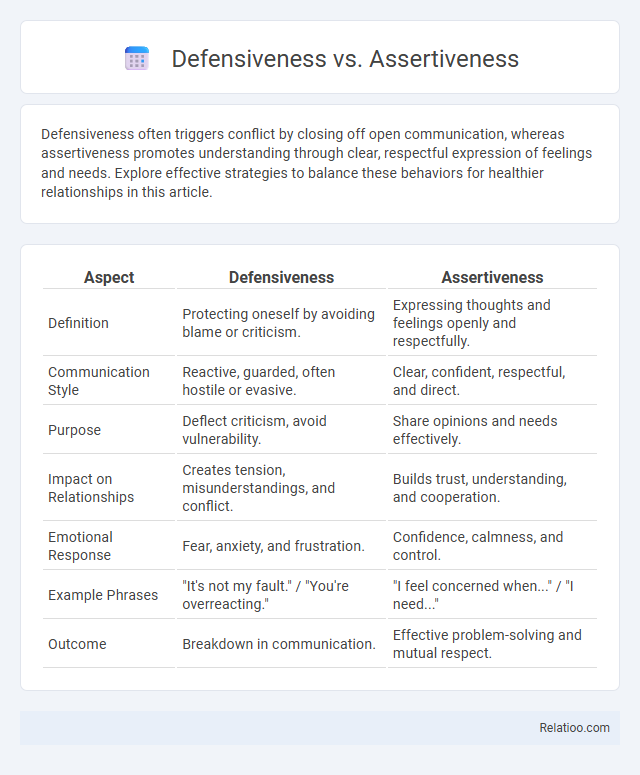Defensiveness often triggers conflict by closing off open communication, whereas assertiveness promotes understanding through clear, respectful expression of feelings and needs. Explore effective strategies to balance these behaviors for healthier relationships in this article.
Table of Comparison
| Aspect | Defensiveness | Assertiveness |
|---|---|---|
| Definition | Protecting oneself by avoiding blame or criticism. | Expressing thoughts and feelings openly and respectfully. |
| Communication Style | Reactive, guarded, often hostile or evasive. | Clear, confident, respectful, and direct. |
| Purpose | Deflect criticism, avoid vulnerability. | Share opinions and needs effectively. |
| Impact on Relationships | Creates tension, misunderstandings, and conflict. | Builds trust, understanding, and cooperation. |
| Emotional Response | Fear, anxiety, and frustration. | Confidence, calmness, and control. |
| Example Phrases | "It's not my fault." / "You're overreacting." | "I feel concerned when..." / "I need..." |
| Outcome | Breakdown in communication. | Effective problem-solving and mutual respect. |
Understanding Defensiveness and Assertiveness
Understanding defensiveness involves recognizing its role as a protective reaction to perceived criticism or threat, often leading to closed communication and conflict escalation. Assertiveness, in contrast, enables you to express your needs and feelings confidently and respectfully without aggression or passivity. Developing assertiveness improves interpersonal relationships by promoting honesty and clarity, reducing misunderstandings rooted in defensive behavior.
Key Differences Between Defensiveness and Assertiveness
Defensiveness often arises from a perceived threat, causing an emotional reaction that can block effective communication, whereas assertiveness involves confidently expressing your thoughts and feelings without aggression. Key differences between defensiveness and assertiveness include the intent and outcome: defensiveness protects ego and can escalate conflicts, while assertiveness promotes mutual respect and resolution. Understanding these distinctions enables you to communicate more effectively, maintaining openness and reducing misunderstandings in personal and professional interactions.
Psychological Roots of Defensiveness
Defensiveness stems from deep-rooted psychological mechanisms such as fear of criticism, low self-esteem, and a threatened sense of identity, triggering protective responses to perceived attacks. Assertiveness, in contrast, is grounded in self-confidence and clear communication, allowing individuals to express their needs without fear or aggression. Understanding these psychological roots highlights how defensiveness can hinder effective communication, while assertiveness fosters healthier interpersonal relationships.
The Benefits of Assertive Communication
Assertive communication fosters clear, honest expression of thoughts and feelings, promoting mutual respect and understanding. It reduces conflicts by addressing issues constructively and encourages healthy boundary-setting, unlike defensiveness which often leads to misunderstandings and escalated tensions. Benefits include improved relationships, enhanced problem-solving, and increased self-confidence, making assertiveness a crucial skill in personal and professional interactions.
Common Triggers for Defensive Reactions
Defensive reactions are commonly triggered by perceived criticism, threats to self-esteem, or fear of failure, leading individuals to protect themselves emotionally. Assertiveness involves expressing thoughts and feelings confidently without provoking defensiveness or aggression, reducing misunderstandings and fostering healthy communication. Recognizing these triggers helps individuals respond assertively rather than defensively, improving interpersonal dynamics and conflict resolution.
How Assertiveness Improves Relationships
Assertiveness enhances relationships by promoting clear communication and mutual respect, allowing you to express your thoughts and feelings honestly without being aggressive or passive. Unlike defensiveness, which can create barriers and misunderstandings, assertiveness encourages open dialogue and problem-solving, fostering trust and empathy between individuals. Your ability to maintain assertiveness ensures conflicts are resolved constructively, strengthening emotional connections and collaboration.
Recognizing Signs of Defensive Behavior
Recognizing signs of defensive behavior involves noticing verbal cues such as denying responsibility, making excuses, or shifting blame during conversations. Physical indicators include crossed arms, avoiding eye contact, or sudden changes in tone, which signal discomfort or resistance. Differentiating defensiveness from assertiveness is crucial, as assertiveness communicates needs clearly and respectfully without triggering defensive responses.
Strategies to Shift from Defensiveness to Assertiveness
Shifting from defensiveness to assertiveness involves recognizing triggers and practicing self-awareness to manage emotional reactions effectively. Implementing communication techniques such as using "I" statements and focusing on expressing needs clearly reduces the instinct to react defensively. Building active listening skills and fostering empathy create a foundation for constructive dialogue and assertive interactions.
Overcoming Obstacles to Assertive Communication
Overcoming obstacles to assertive communication requires recognizing the difference between defensiveness and assertiveness, where defensiveness often triggers emotional barriers that hinder open dialogue. Assertiveness involves clear, respectful expression of your needs without aggression, promoting constructive interactions and reducing misunderstandings. By managing defensive reactions and practicing calm, confident communication techniques, your ability to convey messages effectively improves, fostering better relationships and problem-solving.
Building Long-Term Assertiveness Skills
Building long-term assertiveness skills involves understanding the key differences between defensiveness, assertiveness, and aggression. Assertiveness empowers you to express your thoughts and feelings confidently without undermining others, whereas defensiveness often leads to unnecessary conflict and miscommunication. Fostering assertiveness enhances interpersonal relationships, promotes emotional intelligence, and encourages constructive dialogue for lasting personal and professional growth.

Infographic: Defensiveness vs Assertiveness
 relatioo.com
relatioo.com